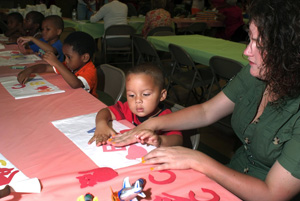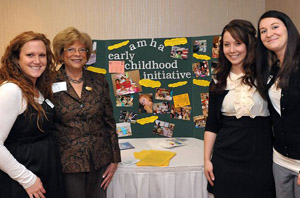
|
Akron Metropolitan
Housing Authority:
Part Four
By Katie Sobiech |
It's been said that it takes a village to raise a child, and from what those at the Akron Metropolitan Housing Authority (AMHA) have seen, this statement has proven itself to be true. The needs of growing children are multi-faceted and require many different types of support.
One great need that AMHA has recognized is the importance of providing a safe, secure environment for kids to live. And in order to do that, they must help stabilize their parents.
"It's not uncommon to see low-income families move two or three times in a year. That kid never gets stability in terms of where they're living. You're thinking about the importance of relationships and friends and being a part of and connected to the school. If you're moving all the time you're never going to really get those roots," Anthony O'Leary, Executive Director of AMHA, said.
AMHA wants to make sure that their families are stable so that they can raise their children in a solid environment. This is why they find it important to work with parents, as well as children, to stop the cycle of poverty.
Equipping Parents to Succeed
Along with being there for the children, AMHA finds it just as important to educate parents. They offer and share plenty of community resources to help parents get back on track and into the work force.
"We encourage them to get their GED's, help them get into a university to further their education and link them with resources to jobs. We know that the more stable a family is, the better that child is going to be," Chris Yuhasz, Community Relations Director of AMHA, explained.
The most important thing Yuhasz says their workers do is establish trusting relationships with each individual first. This way it forms more of a friendship and shows that they do have the family's best interests in heart.

Teaching Self-Sufficiency
One of the greatest programs that they have to end generational poverty is their "Family Self-Sufficiency" program.
The fact that 95% of their residents are female heads of households makes a program like this crucial.
"It's a very intensive case management model where people meet as a group. They're assigned an individual counselor after an orientation and then they basically develop a plan for each person," O'Leary said of the program.
This is a 5-year commitment to receiving intensive counseling care, which has proven to be one of the best things many of them have ever done for themselves and their families.
Witnessing Growth and Success
About 150 people have successfully gone through this program.
"The best success I can remember was a woman who started out part-time at Fed-Ex. She eventually ended up being a supervisor. When she graduated the program she was making over 60,000 dollars a year," O'Leary said.
Upon completion of the program she was given a check for $25,000 which was a rebate from the rent that she paid AMHA over the years.
"You say 'Why would you give them that money?' Well if you look at the cost of rent subsidy, if she'd stayed in public housing all the rest of her adult life that would be mega dollars. Now she's like anybody else. She's working and supporting her family," O'Leary explained.
She also bought her own home and set a great example for her children, stopping the generational cycle of poverty in her family.

From the Classroom to Real World
"In the middle of all this they learn so much more about savings and managing their money. She also started a savings and individual investment account for herself and then for her children. So in addition to the check she got from us, she also had another 15 to 25 hundred dollars accumulated in savings. It's just amazing," Yuhasz said.
"We see a lot of people come through. Some have never had a job and they end up being full-time employed. Several people have bought homes. Almost all repaired bad credit," O'Leary said of the successes.
"It's just amazing. It's literally like a diamond in the rough. You see these folks at the very beginning that are so beaten down by life and at the end it's like you wouldn't really know them. If you saw them walking into the building you would think it was an employee. They're polished, enthusiastic and whatnot," he continued.
A Great Need
"The downside is that about 150 people (have been through the program) and we have thousands of people living in public houses. It's a very small percentage (who can go through the program), because unfortunately the government doesn't fund it," O'Leary said.
The program is so popular that there is a waiting list to get in.
"And that's what you want. You want people to say 'I do want to get up and go to work'," Yuhasz said.
They have also connected with Bridges out of Poverty - a national initiative that several agencies have started implementing in Ohio.
The possibilities are really endless for AMHA and the ways in which they can help our community as a whole, but they need your help! To keep going and be a success, this is going to take a village.
Find out in next week's story more about the issues that these people are facing and how you can help, whether it's individually or volunteering with your company, and what's to come in the future. www.akronhousing.org/
If you have any story ideas, questions, or comments you can contact: Katie@akroneur.com.